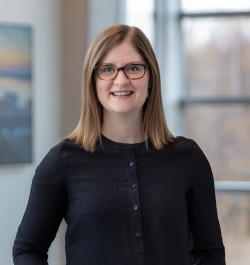
Program Officer Perspectives: Kirstin Yeado Reflects on Rural Guided Pathways Work

Kirstin Yeado
Guided by feedback from rural community college leaders throughout the country, the National Center for Inquiry and Improvement (NCII) recently launched the next phase of their work with rural community colleges: the Rural Guided Pathways Project. The project supports 16 rural community colleges and their partners with the implementation of evidence-based, institution-wide reforms grounded in the guided pathways framework.
Unlike previous guided pathways initiatives, this project is distinct in that it squarely centers rural institutions, which collectively serve learners across 75 counties in 13 states and taps the resources of community partners — like employers and community-based organizations — in supporting student success. The 16 participating institutions represent the diversity of rural America and underscore the unique assets and challenges of rural contexts.

In June of this year, the participating institutions came together in Minneapolis, Minnesota for their first of several institutes. This convening was the first time many college leaders have gathered in two years. It was also the first time I had the opportunity to be with our partners since the launch of our rural strategy in 2019. Energized by the thoughtful insights and lessons shared, I have been reflecting on three themes that emerged during the institute.
- Always start with the end in mind, with the end here being upward mobility for the learner. Across the 75 counties represented in this project, only 35% of the population has an associate degree or higher, compared with 44% of the national population. As high-wage employment opportunities increasingly require postsecondary education and training, the economic health of rural communities depends on rural colleges engaging, retaining and helping learners earn degrees or credentials that provide a pathway to good jobs. Over the next three years, these 16 rural community colleges will do just that. There is no doubt that this work is complex and will prove challenging. But, as Gretchen Schmidt, senior fellow at NCII, reminded the group, “When you get stuck in the work, always go back to the student.” Their academic and career success is the end goal we — institutions and funders alike — must keep in mind.
- This work requires a commitment to systems change. These 16 colleges will implement guided pathways reforms by tackling things like redesigning student advising, adopting developmental education reforms and weaving work-based learning experiences into existing courses. Engaging cross-functional teams in the design and implementation of reform efforts can eliminate the constant churn of new programs owned by a single department. Instead of a series of disconnected reform efforts, imagine the delivery of an integrated system of academic, financial and career support from enrollment to completion to workforce entry. Dr. Ed Massey, president emeritus at Indian River Community College, shared his own institution’s experience with guided pathways by noting, “Working in departmental silos destroys urgency…Pathways was a professional lifestyle change for our college.” We must all maintain a sense of urgency for this work, while also dedicating the time, resources and energy needed to sustain the work in the long-term.
- Cross-sector partnerships are essential. No single reform — or institution — can impact the entire student experience. Dakota Pawlicki, director of Talent Hubs at Civic Lab (which is another grant partner of Ascendium), aptly noted that, “It’s a systems thing, not a single thing.” Engaging partners across the community, like K-12 partners, 4-year transfer partners and employers, will ensure students are connected to the resources they need to succeed and have a clear sense of how their coursework prepares them for the workforce. As Dr. Telly Sellars from Big Sandy Community and Technical College noted during the institute, “We are actively and intrusively changing our culture to focus on relationships and are requiring that all faculty now have relationships with community partners.” If our goal is economic mobility, especially for learners from low-income backgrounds, institutions, community organizations and employers must work together to ensure students are prepared for the world of work.
All of Ascendium’s philanthropic investments are aimed at ensuring more learners from low-income backgrounds have clear pathways to degrees or credentials that translate to good jobs. This work is no exception. Looking forward, I am eager to continue learning with and from the 16 rural community colleges that have made the commitment to transforming their institutions.

